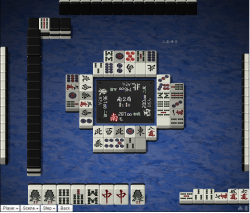Atozuke: Difference between revisions
| Line 20: | Line 20: | ||
=== Counter examples === | === Counter examples === | ||
In these examples, atozuke is not used. In these cases, the hands may win on any of the waiting tiles without the enforcement of the [[chombo]] penalty. | |||
{{#mjt:333m45678s99p}} {{#mjt:6'66z}} Agari: {{#mjt:3s}} or {{#mjt:6s}} or {{#mjt:9s}} | |||
The open call on the [[hatsu|green dragon]] instantly gives the hand a yaku via [[yakuhai]]. | |||
{{#mjt:1234567s123p}} {{#mjt:2'13m}} Agari: {{#mjt:4s}} or {{#mjt:7s}} | |||
[[Sanshoku]] is already embedded in the hand. | |||
{{#mjt:23444m33344z}} {{#mjt:11'1m}} Agari: {{#mjt:1m}} or {{#mjt:4m}} or {{#mjt:4z}} | |||
This hand employs [[honitsu]]. | |||
== Risk of furiten == | == Risk of furiten == | ||
Revision as of 23:59, 16 September 2014
Atozuke 「後付け」 is the state of a "yakuless" tenpai hand, that gains yaku upon the claim of a winning tile. In other words, the hand may currently does not possess yaku, but it is tenpai. The term may to closed hands, until it wins on a tile draw for mentsumo. The use of atozuke is subject to a variable rule, which may or may not allow its use. That decision falls on a league, organization, or house rule.
Cases
Atozuke may be employed in a number of hands.
Examples
For all these examples, the yaku of haitei, houtei, or even rinshan, would render atozuke as moot, as yaku may apply to any needed winning tile. So, if the hand draws the lesser desired tile, then the hand may not qualify for a win. The same case applies for discards. If a win is declared on the improper tile, then the penalty of chombo is invoked for winning a hand without a yaku.

Agari:
or

This hand uses a shanpon tenpai for two tiles. One may produce a yaku, while the other does not.

Agari:
or

This time, the same tiles from the above hand has an open call. At it stands, it needs the haku in order to win.

Agari:
or

This hand has an apparent yaku of sanshoku doukou. However, the latter wait of 3-sou would create a sequence of 1-2-3 sou, as it triggers the effect applied by the lesser valued tile. Suddenly, the required triplet of the three 1-sou disqualifies the apparent yaku.
Counter examples
In these examples, atozuke is not used. In these cases, the hands may win on any of the waiting tiles without the enforcement of the chombo penalty.

Agari:
or
or

The open call on the green dragon instantly gives the hand a yaku via yakuhai.

Agari:
or

Sanshoku is already embedded in the hand.

Agari:
or
or

This hand employs honitsu.
Risk of furiten

Particularly, open yakuless hands run the risk of furiten. That is especially true if the above example draws a 9-pin during the course of the hand, when additional tile draws remain in the wall. In this case, a player cannot declare a win and must discard any tile in the hand. Upon doing so, the player become furiten and must work around it, by changing its hand composion with the remain tile draws or other player discards.
Sakizuke
Sakizuke 「先付け」 is the complete opposite to atozuke. In this case, the practice of using atozuke is disallowed. With this rule in place, a player would have to take greater caution making open calls by either first ensuring yaku or handling the case of furiten.
Rule implementation
The rule of atozuke is commonly enabled or disabled based on organizational preference. If atozuke is disabled, then hands by which atozuke looks to be used in a hand does not have the ability to win.